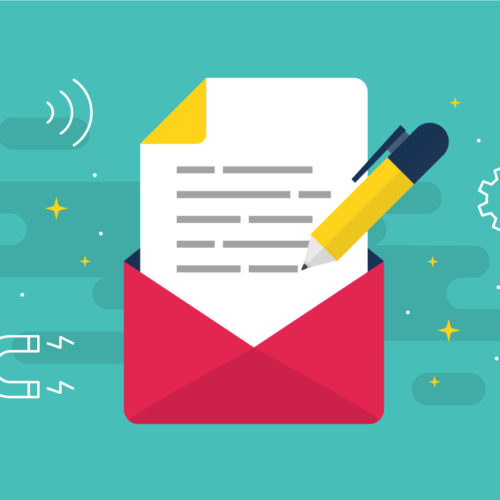How to Write Email Copy That Resonates With Your Readers
Your email is only as good as the words inside it. It doesn’t matter how many fancy graphics or photos you have, whether your words are carefully branded with colors that match your logo, or how many emojis you used in the subject line. Well-written email copy speaks for itself – it doesn’t need bells and whistles (although they ARE nice to have – they’re just not essential). Email marketing, in general, has the potential to be 40x more effective than social media, according to a McKinsey & Company study. But. That’s only if the words in your email do their job. I’m here with your back-to-basics guide on how to write email copy that is not only engaging and relevant to your readers, but actually gets results. Sometimes, solid words and great flow is all you need. ✍ Ready to roll up your sleeves? 9 Steps on How How to Write Engaging Email Copy That Resonates with Your Audience: Table of Contents 1. Learn How to Write a Compelling Email Subject Line 2. Keep the Voice, Tone, and Style in Your Emails Consistent with Your Content (Be Uniquely You) 3. Don’t Worry Too Much About Length… 4. …But Don’t Blather – Get to the Point 5. Be Direct and Encourage Action Whenever Possible 6. Imagine Writing to One Person 7. Step into Their Shoes – Learn How to Write Relatable Email Copy 8. Always Write with a Goal in Mind for Your Email Copy 9. Include at Least ONE Call-to-Action [bctt tweet=”How do you write #email copy that doesn’t need a crutch? (Read: Slick graphics, smooth design, flashy colors, or so many emojis it looks like hieroglyphics. ♀️ ) Find out in @JuliaEMcCoy’s guide. ” username=”ExpWriters”] How to Write Email Copy That Works Without Any Gimmicks: 9 Steps How do you write email copy that doesn’t need a crutch? (Read: Slick graphics, smooth design, flashy colors, or so many emojis it looks like hieroglyphics. ♀️ ) Answer: Like this! Read on. 1. Learn How to Write a Compelling Email Subject Line Your subject line is the key that unlocks your reader’s curiosity, interest, or excitement to read what you have to say. If you can evoke one of these emotions from your reader at this crucial point (and deliver within the actual email message itself), that’s a recipe for a winner. Granted, that’s not saying it’s easy to write this kind of email subject line. It’s really hard. But not impossible. Use Commands or Questions Since the aim of the subject line is both to inform your reader what the email is about and entice them to open it, why not just tell them what to do? Commands use the power of suggestion to make your reader want to click. For example, the subject line “Take the night off from cooking” in an email from a restaurant is more effective than “New seasonal menu!” The first is a command. If you say that to most people, they’ll respond with “Okay, how?” Meanwhile, the second subject line will earn a “So what?” more often than not. A question posed to your reader as your subject line works similarly, because it ignites curiosity, like in this subject line from Digital Marketer: “Is this the hottest career in marketing?” [bctt tweet=”A question posed to your reader as your subject line works well, because it ignites curiosity. #emailmarketingtips ” username=”ExpWriters”] Plumb Your Vocabulary A few strong, solid verbs and adjectives (and a couple of intriguing nouns) may mean the difference between your reader hitting “delete” or opening your message. The right words encourage an emotional response and make your subject line stand out among the dozens of others crowding the average inbox. For instance, in this to-the-point subject line, Sips by (a tea subscription box) uses two positively-associated words and the power of alliteration to make you want to click: “Hacks for Happy Camping” Simple, yet sweet. All it took were two strong words: “hacks” and “happy.” Use an Email Subject Line Scoring Tool If this all sounds like mumbo-jumbo to you, good news: Tools exist to help you create effective email subject lines. I particularly love CoSchedule’s Email Subject Line Tester. It not only scores your subject line, but also explains exactly why it works and the components that make it strong. The more you use this tool, the more you’ll improve your subject line writing skills! 2. Keep the Voice, Tone, and Style in Your Emails Consistent with Your Content (Be Uniquely You) Brand consistency across platforms is important for building trust and a good reputation with readers. That applies to your email copy, too. Ideally, your email copy should reflect the brand voice you have established elsewhere. Any differences will jar your readers, not to mention make you seem less authentic and real. Real-world example: Way back in 2016, when I ventured into building my first courses, I hired a “marketing expert” team (read: ad funnel experts — oops). One of their services was writing all my emails for the sequences to test for better conversion rates. I bit my lip reading phrases like, “I’m a leading influential expert, and I know what I’m doing.” A few of their copy segments ran in an A/B test, and my readers immediately saw a difference and pointed it out (one reader even said, “This is WAY too salesy, and not like you!”). Yeah, chalk that up as just one of my many marketing lessons learned. I strayed from my style, differentiation factor, and tone of voice in my content, which is usually zero B.S., zero fluff, direct, and practical. The new stuff wasn’t me, and the readers just knew. Lesson learned. If you outsource some of your content and copy, don’t hire too many writers. Your style will get watered down. Instead, stick to one or two writers who know your voice inside-out, or ask the agency you hire to dedicate one writer to your content/copy, no matter where or how it appears … Read more

